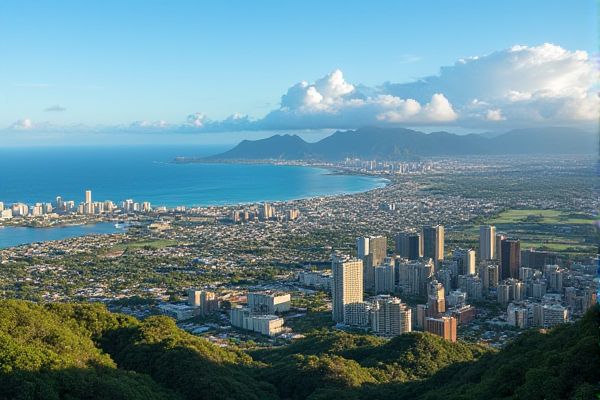
What to know as new resident in Hawaii: Cost of living is high. Island time pace: slower lifestyle. Understand Hawaiian culture and etiquette. Respect native traditions and customs. Limited public transportation system. Diverse and multicultural population. Essential earthquake and tsunami preparedness. Embrace outdoor activities and nature. Limited housing availability. Plan for inter-island travel logistics.
Cost of living is high.
Hawaii has one of the highest costs of living in the United States, driven by its remote location and dependence on imported goods, resulting in high prices for housing, utilities, food, and transportation. The median home prices on Oahu are around $987,000, and rental prices vary widely depending on location.
Island time pace: slower lifestyle.
Living in Hawaii is characterized by a slower pace of life, often referred to as "island time," where activities and daily routines are less rushed, and there is a greater emphasis on enjoying the surroundings, family, and personal well-being. The culture values patience and a more relaxed approach to time, making life on the islands a unique experience. For those considering this lifestyle change, discovering the nuances of island living can be enlightening. The website AlohaTony provides insights and guidance for anyone contemplating a move to Hawaii, helping to understand the cultural shifts and the embrace of a more serene existence amidst stunning natural beauty.
Understand Hawaiian culture and etiquette.
To truly respect Hawaiian culture, one must understand and embrace the Spirit of Aloha. This involves not only learning to greet and interact with others warmly but also respecting sacred sites and traditions. It's important to remember simple customs like removing your shoes before entering homes and practicing malama 'aina, or caring for the land responsibly. Avoiding actions that could harm the environment or cultural heritage is essential. For more comprehensive guidelines, you can visit the Royal Hawaiian Movers website for insightful dos and don'ts that help you navigate Hawaii with respect and awareness.
Respect native traditions and customs.
To respect native traditions and customs in Hawaii, it is crucial to embrace the spirit of Aloha, which includes caring for the community and the environment, respecting sacred sites, and avoiding interactions with protected wildlife, all of which are integral to preserving Hawaiian culture and values. Additionally, understanding and adhering to customs like removing shoes before entering homes and not refusing a lei when offered can help you integrate respectfully into the community. For more detailed insights, visiting the Royal Hawaiian Movers website can be a valuable resource in learning how to respectfully engage with these practices.
Limited public transportation system.
As a new resident in Hawaii, you should be aware that while Oahu has a well-developed public transportation system with "TheBus" and the new Skyline Rail, the other islands—Maui, Kauai, and the Big Island—have less comprehensive bus systems due to their smaller size and population. For more detailed guidance, you can explore Hawaii's Public Transportation System to understand the available options and make your transit experience smoother.
Diverse and multicultural population.
Hawaii is renowned for its diverse and multicultural population, with significant contributions from various ethnic groups including Asians, Caucasians, Pacific Islanders, Hispanics, and Africans. The state's rich history of immigration, particularly driven by the sugar, pineapple, and coffee plantations, has led to a unique blend of cultures, with Filipinos being the largest single ethnicity, representing 25% of the population. For more insight into Hawaii's cultural tapestry, visit this comprehensive overview on Diversity in Hawaii.
Essential earthquake and tsunami preparedness.
As a new resident in Hawaii, it is crucial to know that local tsunamis can follow an earthquake immediately, so move uphill and away from shorelines without waiting for sirens. For distant tsunamis, follow Civil Defense instructions, monitor local radio and TV, and avoid using phone lines for non-emergency calls. To ensure your safety, you can refer to the Tsunami Safe Quick Step Guide for comprehensive guidance on tsunami preparedness and response strategies.
Embrace outdoor activities and nature.
Living in Hawaii opens up a world of exciting outdoor activities to explore. From hiking to stunning volcanoes and picturesque waterfalls, to snorkeling alongside wild turtles and majestic manta rays, the islands of Oahu, Maui, the Big Island, and Kauai offer something for everyone. Engage in thrilling adventures like SCUBA diving and surfing, or unwind on the serene black sand beaches. Don't miss the chance to witness Hawaii's breathtaking natural wonders, such as Waimea Canyon, Haleakala, Hawaii Volcanoes National Park, and the Napali Coast. These can be experienced through exhilarating activities like rappelling, ziplining, downhill bike riding, and even helicopter tours, each showcasing the diverse ecosystems and spectacular landscapes unique to the islands.
Limited housing availability.
As a new resident in Hawaii, you should be aware that the island of O`ahu is facing a severe housing crisis, with approximately 13% of housing units owned by non-residents who leave them vacant, driving up housing costs and limiting availability for local residents. The median rent for a one-bedroom apartment in Honolulu is significantly higher than the national average, and the city is considering an Empty Homes Tax to address this issue and generate funds for affordable housing initiatives.
Plan for inter-island travel logistics.
When planning inter-island travel in Hawaii, consider the unique logistics of each island, including packing light, checking in and out of hotels, renting cars, and the time-consuming process of traveling between islands. You can find more information and tips on the Inter-Island Travel Guide, which offers options for day trips or direct flights to minimize travel time.
